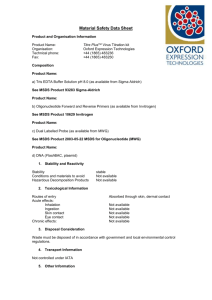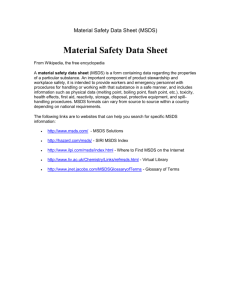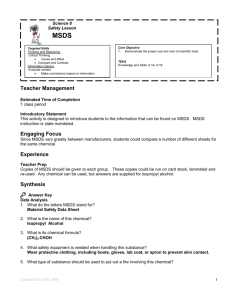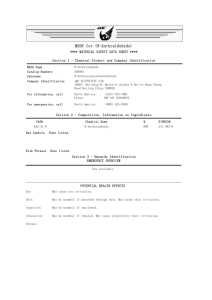Young workers
advertisement
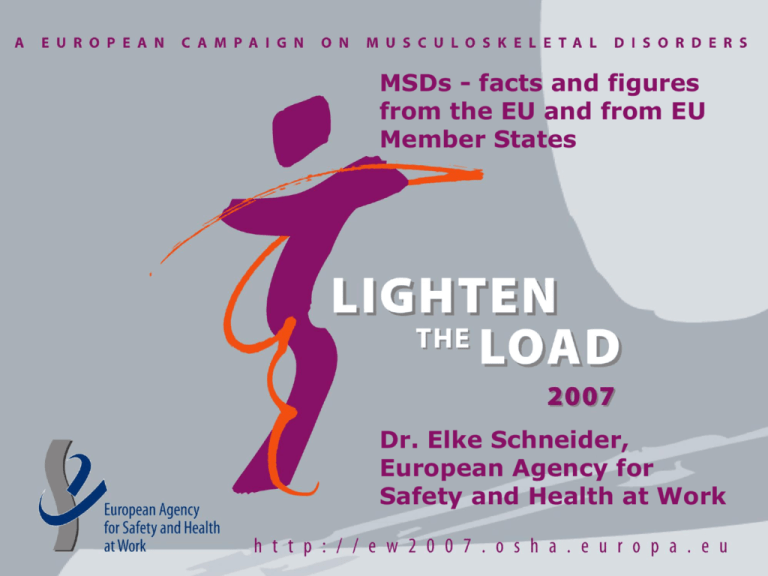
MSDs - facts and figures from the EU and from EU Member States Dr. Elke Schneider, European Agency for Safety and Health at Work This presentation: o The Agency and its European risk observatory o The problem o Risk observatory data – only some to stimulate debate: Women, young workers, healthcare, temporary agency workers, teleworkers o Issues to be considered - conclusions European risk observatory Provide an overview of OSH/MSDs in Europe (no benchmarking or country comparisons) Highlight trends on OSH/MSDs outcomes and risk factors Provide early identification of newly emerging risks in the workplace Identify areas/issues where more information needed http://riskobservatory.osha.europa.eu/ MSDs affect…… Muscles, joints, tendons, ligaments and nerves in the back, neck, shoulders and upper/lower limbs The risk factors, working alone or in combination, include: o physical - force, repetitive movements, vibration, awkward postures o organisational - low autonomy/job satisfaction, repetitive work at a high pace o individual - medical history, physical capacity, age Most common recognised occupational disease in Europe (% of total ODs , EODS 2002-2005. EU15, except Germany, Greece and Ireland) 90 80 70 60 50 40 30 20 10 0 59,0 52,953,055,2 35,034,736,338,1 20,9 17,918,419,0 0,90,80,60,5 Infections 13,113,913,712,8 14,3 13,714,515,6 Diseases of sensory organs Respiratory diseases 4,54,75,25,1 Cancers Neurologic diseases 2002 2003 2004 2005 11,110,78,0 7,1 Skin diseases Musculoskeletal MSD + carpal diseases tunnel EU data – Recognised occupational diseases by gender (% of total ODs , EODS 2002-2005. EU15, except Germany, Greece and Ireland) 90 80 70 60 50 40 30 20 10 0 90 80 70 60 50 40 30 20 10 0 82,184,8 77,377,4 1,1 1,01,1 0,7 0,70,6 0,70,8 Infections Cancers Neurologic diseases 45,3 43,6 43,345,2 37,039,6 33,834,1 0,9 1,11,1 0,8 4,24,7 3,83,5 Diseases of sensory organs Respiratory diseases 2002 2003 2004 15,615,1 11,19,3 Skin diseases Musculoskeletal diseases MSD + carpal tunnel 2005 42,846,0 41,841,8 32,234,5 31,130,7 18,619,819,518,7 0,8 0,70,4 0,4 Infections 6,2 6,67,3 7,2 Cancers 10,711,2 10,611,6 Neurologic diseases 21,019,8 18,119,0 9,1 8,76,6 5,9 Diseases of sensory organs 2002 2003 Respiratory diseases 2004 2005 Skin diseases Musculoskeletal diseases MSD + carpal tunnel EU data - MSDs (EODS 2002-2005) Trends: o MSD + carpal tunnel sdr increased by 32% from 2002 to 2005 (by 39% among women) o MSD + carpal tunnel sdr accounted for 59% of all recognised disease covered by EODS in 2005 (about 85% of all ODs among women) Focuses mainly on upper-limb disorders o mostly three diseases: hand/arm tenosynovitis, epicondylitis of the elbow and carpal tunnel syndrome MSDs – occupational diseases data from Member States are variable, but indicate that it is an important issue UK- MSDs most commonly reported type of workrelated illness, with an estimated 1,012,000 people affected Spain: The number of MSD has fluctuated since 2000 between 12 884 to 20 489 (83,3% to 86,4% of the total of occupational diseases) Germany: The highest number of working days lost due to MSDs (2002: 26%, 2004: 24,3%) Poland: cases of vibration syndrome are the most common chronic musculoskeletal disease Costs due to MSDs (source: eurogip) Groups at risk - Trends in employment (2004 data) More than 66% of the workforce is employed in the services industry Biggest employers manufacturing industry (19%), wholesale and retail trade (16%), health (10%) and education (7%) In 2003, among the jobs created in newly born enterprises in that year, about 72 % were within services and 17 % in construction. Employment has also risen substantially in the elementary occupations and in “service workers and shop and market sales workers” + + - MSDs in service sectors increasing Spain - occupational diseases - MSD EVOLUTION OF MSD (% TOTAL OF THE SECTOR) 90,0 85,0 AGRICULTURE 80,0 FISHING 75,0 INDUSTRY 70,0 CONSTRUCTION 65,0 SERVICES 60,0 TOTAL 55,0 50,0 2000 2001 2002 2003 Source: Occupational Diseases File Spain – body part affected by MSDs by sector Source: VI Encuesta Nacional (2006) Spain, main postures at workplaces 60 52,5 50 40 42,144 36,5 28 30 20 Agriculture 16,2 31,7 Industry Construction 20,3 18,2 15,7 6,2 7,7 10 14,5 10,5 4,6 4,5 Services 0 Standing, rarely walking Standing, frequently walking Sitting, without getting up Sitting, getting up Source: VI Encuesta Nacional (2006) Gender dimension activities where the majority of the EU-27 workforce were women in 2006: o textiles,clothing, leather + footwear manufacturing o retail trade and repair o hotels and restaurants o financial services o health care and social work Recognised MSDs – EU data by gender (absolute number of MSDs and carpal tunnel sdr, EODS 2002-2005. EU15, except Germany, Greece and Ireland) 30000 25458 23145 21951 20232 25000 20000 15000 10000 8748 7885 7064 6617 6901 6113 5861 5033 6397 5821 5721 5153 5000 85 84 82 76 657662721621 Arthrosis of the elbow M eniscal lesions 345312315307 1258119612571197 7338889871123 Bursitis of elbow Bursitis of knee M edial epicondylitis 35163 64 88 0 25000 Carpal tunnel sdr Hand or wrist tenosynovitis 20000 2002 2003 2004 Lateral epicondylitis Arthrosis of the wrist Total M SDs + 23588 carpal tunnel 20542 18694 17026 2005 15000 10000 10996 9243 8236 7420 5516061 6 5385 4994 5402 4414945 9 4031 5000 4 6 5 5 36 32 30 51 A rthro sis o f the elbo w M eniscal lesio ns 35 26 25 178 79 73 90 93 396510682776 B ursitis o f elbo w B ursitis o f knee M edial epico ndylitis 31 7 6 26 0 Carpal tunnel sdr Hand o r wrist teno syno vitis 2002 2003 2004 2005 Lateral epico ndylitis A rthro sis o f the wrist To tal M SDs + carpal tunnel Spain – Health problems of workers by body part and gender Neck ache significantly more frequent in women than men (32 vs.24 %) 24,0 Nape/Neck 32,2 Base: Total of workers 10,0 10,7 12,5 11,4 Should ers Arms/Forearms 1,5 1,2 Elbows 6,8 7,5 Hands/Wrists/Fingers 25,2 Upper Back Male 29,6 Female 40,9 40,6 Lower Back 4,6 4,4 Buttocks/Hips 1,2 1,0 Thighs 4,5 Knees 7,2 12,7 Legs 16,6 6,0 6,7 Feet/Ankles 0 5 10 15 20 25 % workers 30 35 40 45 Source: National Survey of Working Conditions (published 2007) Groups at risk – women in manufacturing (EU data from EWCS 2005) 80 73,1 70 62 62,3 60 50,3 50 40 30 42 27,7 22,324,7 26 66 59,6 56,1 45,5 30 25,8 20,522,5 20,822,8 24,2 20 10,1 10 0 Backache Muscular pains Tiring/painful positions (at least 25% of the tim e) Fem ale Manufacturing Overall fatigue Repetitive hand/arm m ovem ents (at least 25% of the tim e) Fem ale Total EU27 Work at very high speed (at least 25% of the tim e) Total EU27 Vibration (at least 25% of the tim e) Health care sector, Europe About 78% are female. + 10% from 2000-2006 in the EU-27 as compared to the total: 8.6% to 9.5 % of all workers Within the female working population it has increased from 15 to 17%. About 3 % of the EU working population (or 6.8 million) are women who work in the health care sector and who have to lift or move people. In the health care sector, an estimated 6-7 million women lift or move people and 3-4 million report backpain Health care workers carry more than construction workers (Germany, BAuA survey, published Nov.2007) 2 in 3 have to carry heavy loads (compared to 1 in 2 for construction workers) 93,8% have to do their work standing 36% have to work in unfavourable postures (kneeling, bending, squatting, etc.) 71% have to do more than one task at a time More than ¾ (76%) work shifts More than half work nights (51%) Almost all work Saturdays, Sundays and holidays (94%, 91,5%) Health care workers carry more than construction workers (Germany, BAuA survey, published Nov.2007) 57% men and 64 % women have back pain 66 % women and 54% men have pain in neck and shoulders 37% of the women have pain in the legs > 40% suffer from high emotional load (compared to 11 % on average) More than 1 in 4 feel that they hardly cope (27 vs 16.6 %) Twice as many as on average have sleeping problems (37% vs. 19%) Groups at risk –Young workers Physically demanding tasks common among young workers which means that they are at considerable risk of developing MSDs. ES: > 75% newly declared occupational diseases of young workers in 2004 MSDs estimated 4 million young workers in the EU under the age of 25 have backpain BE: In a study of 716 healthcare and distribution workers (aged 25-29) 13 % had developped back pain lasting > 7 days within 1 year Groups at risk – young workers in manufacturing (EU data from EWCS 2005) 100 90 80 70 60 50 40 30 20 10 0 87,7 78,7 76,2 72,9 66,1 62,3 69,9 67,3 59,6 51,9 41,9 35 Carrying/m oving heavy loads (at least 25% of the tim e) Standing/w alking (at least 25% of the tim e) <=24 Manufacturing Repetitive hand/arm m ovem ents (at least 25% of the tim e) <=24 Total EU27 Work at very high speed (at least 25% of the tim e) Total EU27 Vibration exposure notable for women and young workers (EU data from EWCS 2005 (for YW) and 2000/2005) 100 90 80 70 60 50 40 30 20 10 0 87,7 78,7 76,2 72,9 66,1 62,3 69,9 67,3 59,6 51,9 YW 49,3 41,9 35 26,1 24,2 20 18 16 13 14 Carrying/m oving 12 heavy loads (at 10 8 least 25% of the 6 4 tim e) 2 0 1995 18 13,9 Standing/w alking (at least 25% 8 of the tim e) Repetitive 9,2 hand/arm m ovem ents (at least 25% of the tim e) 2000/2001* <=24 Manufacturing 2005 Work atEU15 very high Vibration (at least speedNMS12 (at least 25% of the tim e) 25% of the tim e) <=24 Total EU27 Women Total EU27 Temporary Agency work – an example (Germany, SUGA 2006) Most of the jobs are in manufacturing, unskilled labour, eg. in construction, and service jobs, including retail and lowskilled office work – increasing trend (x 3 1995-2006) About half of these workers have contracts with a duration between 1 week and 3 months Working conditions of temporary agency workers o o o o o o More standing (76% vs. 57%) More carrying of heavy loads (37 vs. 24 %) More unfavourable postures (19 vs. 16%) More noise, unfavourable climatic conditions, PPE use More paced work (39 vs. 32 %) Less job control (31 vs. 25 %) Temporary Agency work – an example (Germany, SUGA 2006) Health problems of temporary agency workers o More: • pain in hands and arms (32 vs. 22%) • pain in legs and feet (29 vs. 22%) • pain in the knees (25 vs. 19%) • tiredness, exhaustion (48 vs. 43%) o Less satisfied with • physical working conditions (26 vs 16 %) • training opportunities (46 vs. 30%) • type and content of work (21 vs. 7%) • opportunity to apply skills (24 vs. 13%) Teleworkers - UK-horizon scanning Currently, 8% of the workforce are teleworkers. It is suggested that by 2015, 70-80% of workers could be, at least partially, working from a remote location. mainly increase in people working in different places using home as a base, rather than working from home, levels of which have remained relatively stable. Points for consideration and discussion Include groups normally not at focus of attention (young workers, women, temporary agency workers) Consider changes in employment patterns (move from industry to service professions, working at home, home carers, working from a remote location, temporary agency work, shortterm contracts) Include workers on shift work, night and weekend work, and part-time workers – working time patterns are changing! Include exposure to vibrations Detailed monitoring is necessary, and important, also to assess gender differences Look closer at risks involving lower limbs Addressing the “whole load on the body” — i.e. all the strains Tailor rehabilitation policies to include all groups National policies - how Member States address MSDs Examples UK-horizon scanning, issues for OSH: agency workers, use of keyboards and of mobile devices, increased wireless use (e.g. ‘BlackBerry Thumb’), Austria: 2007 programme and new OSH stategy: for health sector and transport assessment of MSDs risk factors, training of labour inspectors and development of tools to monitor exposure for inspection and for the enterprise level Germany: OSH strategy has identified the decrease in MSDs as one of its main strategic goals Where to find out more There is more help and advice on how to stay safe and healthy at work on the Lighten the Load website - http://ew2007.osha.europa.eu And the MSDs Single Entry Point http://osha.europa.eu/topics/msds And the Risk observatory Webpage: http://riskobservatory.osha.europa.eu/ Thank you for your attention!
